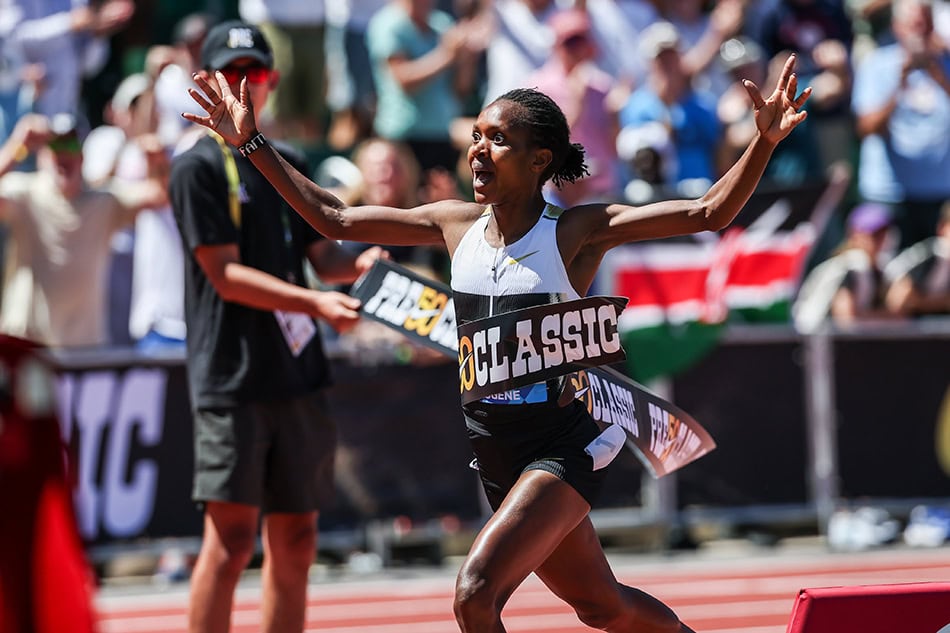We all have our favorite types of weather for different activities—whether it’s sunny skies for a beach day, crisp air for a hike, or a warm afternoon for a picnic in the park.
But when it comes to running, especially racing, is there such a thing as perfect weather? Is there an optimal temperature and humidity level that supports peak performance?
Research suggests that the ideal marathon temperature varies slightly by sex and race-day conditions. For most runners, optimal performance occurs at temperatures of around 42.6°F (5.9°C) for men and 45.9°F (7.7°C) for women.
In this guide, we’ll dive into what makes for the “perfect running weather” and unpack the physiological challenges that arise when conditions are less than ideal.

What Is the Ideal Marathon Temperature?
Most runners, exercise physiologists, and coaches agree that “perfect running weather” typically means a dry day with mild temperatures, no precipitation, and little to no wind.
Adverse conditions, such as strong winds, rain, sleet, snow, hail, or thunderstorms, are far from ideal and can significantly impact your performance.
Wind, for example, will almost inevitably create a headwind at some point during your run—unless you’re running in a straight line with a consistent tailwind, which is rare. Headwinds increase resistance, forcing your body to work harder to maintain its pace.
Precipitation can also slow you down. Rain or snow can affect visibility, make it harder to regulate body temperature, reduce traction, and soak your clothing and shoes.
These factors not only make running uncomfortable but also increase the risk of blisters, chills, and fatigue—all of which can directly impact your performance.
But, a major factor that plays into the “ideal running weather“ is the temperature. So, is there an optimal running temperature?
One study1El Helou, N., Tafflet, M., Berthelot, G., Tolaini, J., Marc, A., Guillaume, M., Hausswirth, C., & Toussaint, J.-F. (2012). Impact of Environmental Parameters on Marathon Running Performance. PLoS ONE, 7(5), e37407. https://doi.org/10.1371/journal.pone.0037407 compared the results of six marathons based on four environmental factors: temperature, humidity, dew point, and the atmospheric pressure at sea level.
The air temperature was found to have the most significant effect on running performance and dropout rates of runners of all levels, while humidity affected faster women and men only.
The more the air temperature increased above the “optimal running temperature,” the slower the running speeds and the higher the withdrawal rates.

The best temperature for marathon running—which was the temperature where runners ran the fastest—for each performance level was as follows:
| Performance Level | Ideal Running Temperature for Men (°F) | Ideal Running Temperature for Men (°C) | Ideal Running Temperature for Women (°F) | Ideal Running Temperature for Women (°C) |
| Elite Runners (top 1% of runners) | 38.9 | 3.81 | 49.8 | 9.91 |
| Top Quartile (top 25% of finishers) | 42.8 | 6.02 | 44.3 | 6.85 |
| Median | 43.2 | 6.24 | 44.1 | 6.75 |
| Third Quartile | 45.4 | 7.42 | 45.2 | 7.35 |
These results suggest that the best temperature for running for most runners is around 5.9°C or 42.6°F for men and 7.7°C or 45.9°F for women.
A separate study2Knechtle, B., Di Gangi, S., Rüst, C. A., Villiger, E., Rosemann, T., & Nikolaidis, P. T. (2019). The role of weather conditions on running performance in the Boston Marathon from 1972 to 2018. PLOS ONE, 14(3), e0212797. https://doi.org/10.1371/journal.pone.0212797 that looked at the relationship between Boston Marathon race results and the weather on race day found that the optimal temperature for marathon performance is between 44° F and 59° F (7–15° C), though the best results occur at wet bulb temperatures below 7.8 °C (46 °F).
There was a fairly linear relationship of slower average finish times for each additional 1 °C increase in temperature above the ideal marathon temperature.

Why Is It So Hard To Run In The Heat?
You often won’t get “perfect” running conditions on race day, whether too hot or too cold.
So, what physiological consequences occur when it is hotter than ideal?
The first hydrological response to running in the heat is that you’ll start sweating sooner and more heavily than when running in optimal marathon temperatures.
Sweating is really only effective at cooling down your body temperature in the sense that the excess heat energy is used to help evaporate the moisture that builds up on your skin in the form of sweat.
The heat energy is released as it is used to transform the phase of matter of sweat from liquid water to vapor. Heat energy is dissipated by helping evaporate sweat from your body, lowering your core temperature.
However, when it’s humid, the moisture content in the air prevents sweat from evaporating readily,3Che Muhamed, A. M., Atkins, K., Stannard, S. R., Mündel, T., & Thompson, M. W. (2016). The effects of a systematic increase in relative humidity on thermoregulatory and circulatory responses during prolonged running exercise in the heat. Temperature, 3(3), 455–464. https://doi.org/10.1080/23328940.2016.1182669 so, the perfect running weather not only involves the ideal temperature for marathon running but also a relatively dry day with low humidity.
Running in the heat also increases cutaneous blood flow (blood flow to the skin) to help dissipate excess heat. This can reduce blood flow to your muscles, making your run tougher.
Another physiological phenomenon that can occur when you’re running a marathon above the ideal marathon temperature is cardiac drift.
Cardiac drift is the gradual upward creeping of the heart rate during endurance exercise, mainly due to dehydration.
As blood plasma volume decreases, the stroke volume, or how much blood is pumped per beat, also decreases. Your heart rate has to increase to compensate for the relative reduction in stroke volume in order to maintain cardiac output.

Even when marathon runners do a good job staying on top of hydration needs, it’s typical to see some amount of cardiac drift throughout a marathon.
Though cardiac drift occurs to some degree during a marathon or long run, the hotter and more humid it is, the more significant the increase in heart rate.
With cardiac drift, although a marathon runner might complete the race at a fairly even pace, their average heart rate will likely still gradually increase throughout the race.
When the temperature is above the “optimal running temperature and humidity,” it will result in a much higher marathon heart rate.
When you are running above the ideal marathon temperature, cardiac drift will cause your heart rate to rise, which can increase your rate of perceived exertion and decrease your efficiency.
Research demonstrates that runners who average 5:45 min/mile pace or faster slow down about 1 second per mile for each 1° C (1.8° F) increase in temperature above 15° C (59° F), whereas runners who average 7:25-10:00 min/mile pace slow down 4-4.5 seconds per mile with this same temperature increase.4Vihma, T. (2009). Effects of weather on the performance of marathon runners. International Journal of Biometeorology, 54(3), 297–306. https://doi.org/10.1007/s00484-009-0280-x
Although we can’t do much to control the weather on race day, staying well hydrated can help minimize the effects of cardiac drift because your blood plasma level will stay as close to normal as possible.
As we know, we can’t control Mother Nature. Even if we plan accordingly and choose a marathon that should have “ideal” conditions the day of, the weather can either creep up to hot and humid conditions or plunge to a frigid chill, depending on the location and season.
I have put together my top coaching tips for running in both extremes so you can be prepared for whatever Mother Nature throws at you and still have a great race day.

Tips For Running In The Heat
Running in heat and humidity requires smart strategies to stay safe and perform at your best.
Hydration is critical, so start by pre-hydrating with an electrolyte drink in the hours leading up to your race. During your marathon, drink regularly at aid stations to replenish fluids and maintain electrolyte balance.
Electrolytes such as sodium, potassium, and magnesium are essential for replenishing what you lose through sweat, thereby preventing cramping and fatigue.
Consider using electrolyte tablets or sports drinks, especially for longer races, to replenish your body’s electrolytes. Remember, thirst alone isn’t always a reliable indicator of dehydration, so stick to a hydration plan throughout the race.
Dressing appropriately also makes a significant difference in staying cool. Wear lightweight, loose-fitting clothing in light colors that reflect, rather than absorb, heat.
Opt for quick-drying, moisture-wicking fabrics to keep sweat from sticking to your skin. A visor can protect your face from the sun, and sunglasses will reduce glare.
Also, use cooling strategies such as pouring water over your head, wrists, or neck at aid stations to help regulate your body temperature.
Finally, pace yourself conservatively early in the race to avoid overheating and allow your body to adapt to the challenging conditions.
Tips For Running In The Cold
When the temperatures dip below our “ideal” running weather, we have some tried-and-true tips to help make your run more comfortable.
When racing, dress as if it’s 20°F warmer to avoid overheating and layer strategically. To stay dry, start with a moisture-wicking base layer (avoid cotton!), add an insulating mid-layer like fleece or thermal, and finish with a windproof and waterproof outer layer.
Protect your extremities with gloves, thermal socks, and accessories such as hats, headbands, or buffs for face and ear coverage.
Make sure to warm up with dynamic exercises, such as high knees or jumping jacks, to get your blood flowing and your muscles warmed up.
Don’t skip hydration—your body loses water even in winter, so drink plenty before, during, and after your run to stay energized and perform at your best.
As you can see, regardless of the weather conditions—whether ideal, too hot, or too cold —you need to stay hydrated. Here is our complete guide to hydration for runners:













For some strange reason, people seem to always get really freaked out by rain. However, I’d much rather run in the rain than in the heat. For example, I will never forget Boston in 2012 when it was close to 85° that day. While Boston in 2018 was a monsoon. I ran a much better and more comfortable race that day versus in 2012.